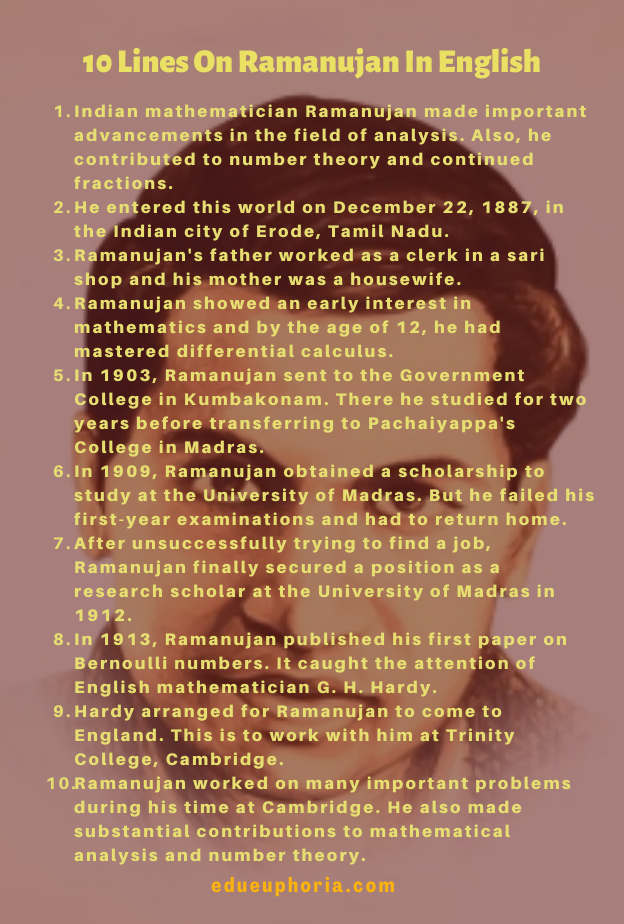There have been many brilliant mathematicians throughout history. Each mathematician has contributed something unique to the subject. Because so many people offered competing lines of reasoning. This results in making mathematics an independent foothold in the humanities. We’ll be discussing 10 lines on Ramanujan or 10 lines about Ramanujan.
Also, we will check the essay on Ramanujan (paragraph on Ramanujan). Let’s check them one by one.
10 Lines On Ramanujan In English

- Indian mathematician Ramanujan made important advancements in the field of analysis. Also, he contributed to number theory and continued fractions.
- He entered this world on December 22, 1887, in the Indian city of Erode, Tamil Nadu.
- Ramanujan’s father worked as a clerk in a sari shop and his mother was a housewife.
- Ramanujan showed an early interest in mathematics and by the age of 12, he had mastered differential calculus.
- In 1903, Ramanujan sent to the Government College in Kumbakonam. There he studied for two years before transferring to Pachaiyappa’s College in Madras.
- In 1909, Ramanujan obtained a scholarship to study at the University of Madras. But he failed his first-year examinations and had to return home.
- After unsuccessfully trying to find a job, Ramanujan finally secured a position as a research scholar at the University of Madras in 1912.
- In 1913, Ramanujan published his first paper on Bernoulli numbers. It caught the attention of English mathematician G. H. Hardy.
- Hardy arranged for Ramanujan to come to England. This is to work with him at Trinity College, Cambridge.
- Ramanujan worked on many important problems during his time at Cambridge. He also made substantial contributions to mathematical analysis and number theory.
| Also Read: 10 Lines On Dr B.R. Ambedkar In English |
Essay On Ramanujan (Paragraph on Ramanujan)
In the fields of mathematical analysis, number theory, and continuous fractions, Ramanujan of India made important contributions. He was born in Erode, Tamil Nadu, India in 1887 and died in 1920 at the age of 32.
Ramanujan initially developed his own mathematical research in isolation without any formal training. He later began corresponding with British mathematician G. H. Hardy, and their collaboration proved highly fruitful. Moreover, Hardy described Ramanujan as “the most natural genius he had ever met.”
Ramanujan made substantial contributions to the theory of numbers. It includes work on the partition function and the mock theta functions. He also worked on elliptic functions, continued fractions, and infinite series expansions.
Ramanujan’s work inspired a vast amount of further research. And he always considers one of the greatest mathematicians of all time. Also, in 2012, Google celebrated his 125th birthday with a doodle on its homepage. The Ramanujan Journal is dedicated to publishing work in all areas inspired by his mathematics.








